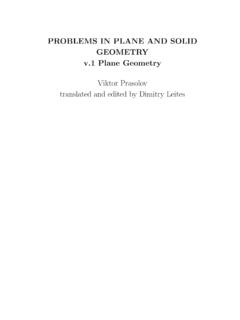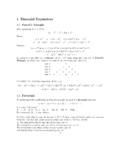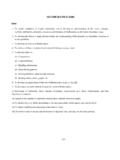Transcription of Primary Mathematics Challenge – November 2013
1 Primary Mathematics Challenge November 2013 Answers and Notes These notes provide a brief look at how the problems can be solved. There are sometimes many ways of approaching problems, and not all can be given here. Suggestions for further work based on some of these problems are also provided. P1 B (5) P2 B (4) 1 A m (B) and (C) are equal, as are (D) and (E). 2 D 20 There are 20 red and 10 blue counters. 3 B 40 min From pm to pm is 50 minutes, of which 10 minutes is a break. 4 E 6 If we label from left to right the three obvious rectangles P, Q and R, we can see that P and Q together form another, as do Q and R, and also P and Q and R. 5 C 30 Numbers with a factor of 2 and 5 are the multiples of 10; the smallest positive such number with a factor of 3 is 30. This is the lowest common multiple (LCM) of 2, 3 and 5.
2 6 B 2 If there is one answer that the machine always gives, we might try starting off with 0: 0 3 6 6 2. Other inputs produce the same result: 6 2. 7 B 90 cm After the first bounce the ball will rise to 120 cm, and then to 90 cm. 8 D 22 A 3 3 3 cube requires 27 smaller cubes, so Finn needs 27 5 = 22 more. 9 A After I get out the depth of water will fall almost instantly, and then gradually as the water drains away. 10 B 5 The only multiple of 7 between 240 and 249 is 245. 11 C south After every 4 Right turns the troops will be facing north again; so after 68 turns they are facing north, after 69 turns east, and after 70 turns south. 12 C 1 The cost of 45 single copies is , whereas 50 copies will be 13 C Each of the unshaded triangles occupies a quarter of the square (as shown on the right); so the fraction of the room in which the camera can detect is 1 (2 1/4) = 1/2.
3 14 D 180 000 In a year of 365 days, the number of bags is 365 500 ( 180 000). 15 D 275 000 A quarter of a million is 250 000, and 10% of this is 25 000; 250 000 + 25 000 = 275 000. 16 D 10 mph Speedy cycles half a mile in 3 minutes, and so 1 mile in 6 minutes. 17 C Isobel Taking the sentences in order and using < as shorter than , we have: S < I, then S < E < I and finally S < E < I < A < R . 18 E 36 cm2 Thinking of an octagon fitted into a square (as shown on the right), one can see that each of the triangles has an area of (10 10 64) 4 = 9 cm2. But each square comprises four triangles, so the area of each square is 4 9 = 36 cm2. 19 B Out of 18 chocolates there are 6 2 = 12 of the flavours that she likes. So the probability of Swee Tuth getting one she doesn t like is 6/18 = 1/3.
4 20 A 45% There are twice as many triangles as squares but, because the height of an equilateral triangle must be rather less than its side length, the combined area of two triangles (forming a rhombus) must be less than that of a square. As a result, less than half of the tessellation is covered by triangles, and only option (A) is less than 50%. 21 36 The highest possible pile of tins is 80 cm, the height of 8 tins. As this pile is also 8 tins wide, the pile will also fit widthways in the window. The number of tins in each pile is a triangular number (not surprisingly), and the eighth triangular number is 36. 22 6 Since Tom runs one and a half times as fast as Jerry, Tom moves round the clock 3 places for every 2 for Jerry. We can consider their progress in the table below: position on clock face Tom 12 3 6 9 12 3 6 Jerry 6 8 10 12 2 4 6 Therefore the first time they meet is at the number 6.
5 1 2 1 3 23 384 The cubes painted on one face only are on the outside of the cube but not at the edges or corners. Each of the six 10 10 faces will have 8 8 such painted cubes, so the total number is 6 8 8 = 384. 24 16 A pattern of 18 tiles along and 14 tiles up, will require 3 complete rows of 4 patterns of 16 tiles (J) and 4 patterns of 8 tiles (K) as well as 3 patterns of 8 tiles (L) and 1 pattern of 4 tiles (M): J ( 12) K ( 4) L ( 3) M ( 1) 10 white 5 white 5 white 3 white Therefore the number of white tiles will be 12 10 + 4 5 + 3 5 + 3 = 158 and so Tyler will need to buy 160 tiles in 16 packs. 25 5 The first 9 numbers are single digits, so after writing these Kim has 91 digits left. Each number from 9 to 99 requires two digits, and so after writing 91 further digits Kim will have written another 45 complete two-digit numbers (up to the number 54); the one digit left will be a 5, the first digit of 55.
6 Some possibilities for further problems Q4 One could consider the diagram on the left and spot a connection with triangular numbers. If you consider the number of rectangles (including squares, of course) in the diagram on the right you get a nice combination of square and triangular numbers. Q5 If you continued with only prime numbers, the LCM would simply be the product of all of them. But how big is the LCM of 2, 3, 4, 5, 6, 7, 8, 9 and 10? Q6 Using algebra, we can see why the machine always gives the answer 2: if you were to start with a number n, then the sequence becomes: n n + 3 2n + 6 2n + 6 2n = 6 2. Can you design another complex machine that gives the same answer whatever number is put in? Q9 If the axes were not labelled as time and depth, but had different labels, what real events could the other graphs in this question represent?
7 Q10 You will know how to test whether a number is a multiple of 5 or 10, or 3 or 9, or 4 or 8, without doing the actual calculation for dividing. There are divisibility rules for many numbers, including for divisibility by 7. See or (to take it even further) Q13 How would it be possible in a similar way for the camera to detect objects in 2/3 of the room? Q14 What if you were to consider the whole of the UK and assume that half the population will take one new plastic bag each week how many bags would this amount to each year? In fact, in 2012, some billion bags were given away by major supermarkets (about 250 for each UK household), though this number is decreasing [source: ]. Q17 In this question, you can find the order of all five girls; can you make a question for which it is impossible to work out entirely the order of the girls, but still possible to work out which of them has the middle (median) height?
8 Q18 The diagram shows regular octagons and squares tessellating what other combinations of several different regular polygons tessellate with each other? Can you find anything else out about semi-regular tessellations what is the difference between regular and semi-regular tessellations? See the interactive site Q20 The percentage covered by triangles is actually about Is it possible to change the triangles to isosceles triangles so that the tessellation is equally covered by triangles and squares? Q21 If the window is deep enough for it, Willy could stack the tins in the shape of a square based pyramid with, for instance, 9 on the bottom, 4 above that and 1 on the top. The numbers of tins he could use in each pyramid stack are known as square pyramidal numbers. For further details, see If Willy preferred pyramids with triangular bases, the number of tins would be the tetrahedral numbers.
9 Do you know of the connections between square numbers, triangular numbers, tetrahedral numbers and Pascal s triangle? If not, see The PMC is organised by The Mathematical Association







